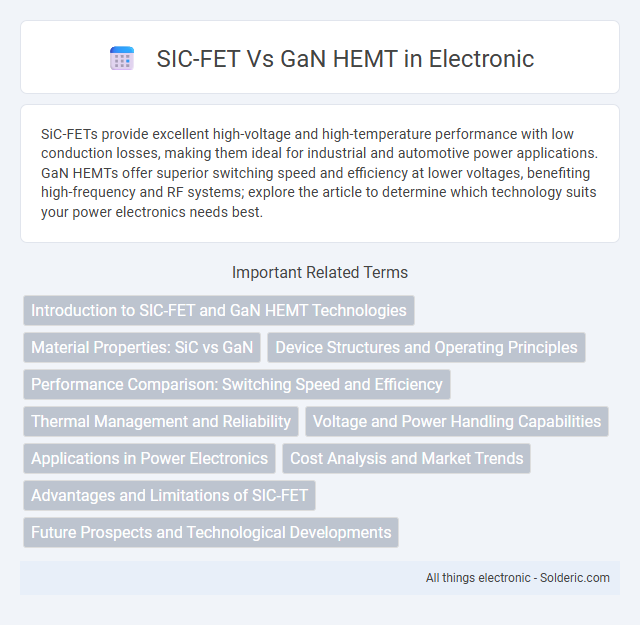SiC-FETs provide excellent high-voltage and high-temperature performance with low conduction losses, making them ideal for industrial and automotive power applications. GaN HEMTs offer superior switching speed and efficiency at lower voltages, benefiting high-frequency and RF systems; explore the article to determine which technology suits your power electronics needs best.
Comparison Table
| Feature | SIC-FET | GaN HEMT |
|---|---|---|
| Material | Silicon Carbide (SiC) | Gallium Nitride (GaN) |
| Electron Mobility | Lower (~900 cm2/V*s) | Higher (~1500-2000 cm2/V*s) |
| Breakdown Voltage | High (up to 10 kV) | Moderate to High (up to 650 V to 1.2 kV typical) |
| Switching Speed | Fast, limited by MOSFET structure | Very fast due to 2DEG channel |
| Thermal Conductivity | Excellent (3.7 W/cm*K) | Good (1.3-2 W/cm*K) |
| On-Resistance (RDS(on)) | Low, but higher than GaN | Very low, optimal for high-efficiency |
| Cost | Higher than silicon, moderate | Generally lower than SiC, cost-effective |
| Applications | High voltage power conversion, EVs, industrial | RF amplifiers, power supplies, 48V systems |
Introduction to SIC-FET and GaN HEMT Technologies
SIC-FET (Silicon Carbide Field-Effect Transistor) and GaN HEMT (Gallium Nitride High Electron Mobility Transistor) are prominent semiconductor technologies known for high efficiency and power density in power electronics. SIC-FET offers superior thermal conductivity and robustness, making it ideal for high-voltage applications, while GaN HEMT excels in high-frequency switching and low on-resistance, enhancing performance in RF and power conversion systems. Understanding these technologies enables optimizing your power device selection based on specific efficiency, switching speed, and thermal management requirements.
Material Properties: SiC vs GaN
Silicon Carbide (SiC) offers superior thermal conductivity and higher breakdown electric field compared to Gallium Nitride (GaN), enabling devices that can handle higher power densities and operate at elevated temperatures. GaN exhibits higher electron mobility and saturation velocity, resulting in faster switching speeds and improved efficiency in high-frequency applications. Your choice between SiC and GaN depends on the balance of thermal management and switching performance required for your specific power electronics design.
Device Structures and Operating Principles
SiC-FETs utilize a trench MOSFET structure with a super-junction design that combines a high-voltage SiC JFET in series with a low-voltage MOSFET, enhancing efficiency and switching speed. GaN HEMTs feature a lateral transistor structure based on a heterojunction between GaN and AlGaN, creating a high-mobility two-dimensional electron gas channel that enables extremely fast switching and low on-resistance. Your choice between these devices depends on the specific operating voltage, switching frequency, and thermal performance requirements of your application.
Performance Comparison: Switching Speed and Efficiency
SiC-FET devices exhibit superior switching speed due to their lower gate charge and reduced input capacitance, enabling faster transition times and higher frequency operation compared to GaN HEMTs. GaN HEMTs offer exceptional efficiency at high frequencies with low on-resistance and minimal gate drive losses, making them ideal for applications requiring high power density and efficiency. Overall, SiC-FETs excel in robust high-voltage switching scenarios, while GaN HEMTs dominate in ultra-high-frequency and efficiency-sensitive environments.
Thermal Management and Reliability
SiC FETs exhibit superior thermal management due to their high thermal conductivity (approximately 3.7 W/cm*K), enabling efficient heat dissipation and operation at junction temperatures exceeding 175degC. GaN HEMTs, with lower thermal conductivity (~1.3 W/cm*K), require advanced cooling solutions to maintain reliability under high-power densities. Reliability in SiC FETs benefits from robust material properties and established packaging techniques, whereas GaN HEMTs face challenges such as trapping effects and thermal runaways, demanding ongoing improvements in epitaxial growth and device design.
Voltage and Power Handling Capabilities
SiC FETs offer superior voltage handling capabilities, often exceeding 1200V, making them ideal for high-voltage power applications. GaN HEMTs excel in high-frequency operation but are typically limited to voltages under 900V, providing efficient power switching with lower conduction losses. Your choice depends on whether higher voltage endurance or higher switching speed is the priority for your power system design.
Applications in Power Electronics
SiC FETs excel in high-voltage power electronics applications due to their robustness, high thermal conductivity, and low switching losses, making them ideal for electric vehicle inverters and industrial motor drives. GaN HEMTs offer superior efficiency and faster switching speeds at lower voltages, optimizing performance in data center power supplies and 5G base station amplifiers. Your choice between SiC FETs and GaN HEMTs depends on the specific voltage and switching frequency requirements of your power electronics application.
Cost Analysis and Market Trends
SiC-FET devices generally command higher upfront costs compared to GaN HEMTs due to their mature manufacturing processes and robust high-voltage performance, making them ideal for industrial and automotive applications. GaN HEMTs offer cost advantages in lower-power, high-frequency markets such as telecommunications and consumer electronics, driven by their superior efficiency and smaller form factors. Your choice should consider market trends shifting towards GaN for rapid growth in 5G infrastructure and SiC for expanding electric vehicle adoption, influencing both cost dynamics and long-term investment value.
Advantages and Limitations of SIC-FET
SiC-FETs offer high thermal conductivity, enabling efficient heat dissipation and operation at temperatures up to 175degC, which supports reliability in harsh environments. They exhibit low on-resistance (R_DS(on)) and fast switching speeds, making them ideal for high-power applications such as electric vehicles and industrial drives. However, SiC-FETs can face challenges including higher cost compared to silicon devices and limited availability of mature fabrication processes relative to GaN HEMTs, which excel in high-frequency, low-voltage scenarios.
Future Prospects and Technological Developments
SiC MOSFETs exhibit robust thermal performance and high-voltage capabilities, making them suitable for applications like electric vehicles and renewable energy systems, while GaN HEMTs promise higher switching speeds and efficiency ideal for RF amplifiers and power conversion. Emerging innovations in GaN HEMT technology focus on enhancing device reliability and expanding power handling, whereas SiC advancements aim at reducing manufacturing costs and increasing wafer size to support mass adoption. Your choice between these semiconductors depends on the specific requirements for efficiency, frequency, and thermal management in future electronic and power systems.
SIC-FET vs GaN HEMT Infographic

 solderic.com
solderic.com